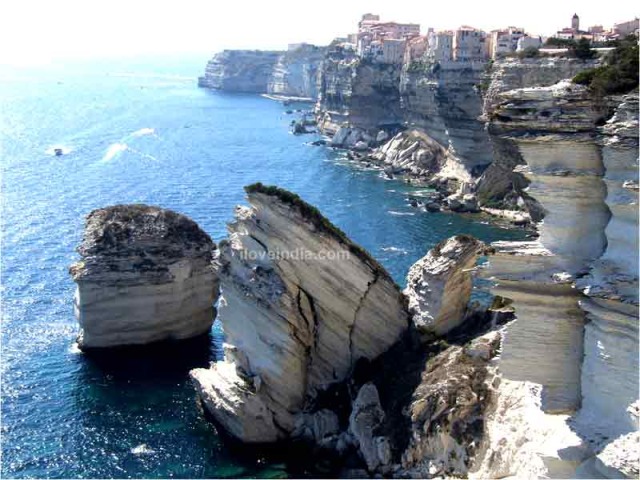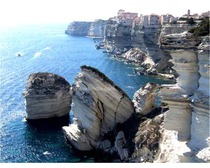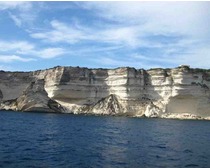The high elevations and spectacular scenery of Corsica attracts numerous tourists from across the globe. Check out this article to find things to do and places to see in Corsica.
Corsica Tourist Attractions
Location: Southeast of France in the Mediterranean Sea 

Language: French, Corsican (Corsu)
Best Time to Visit: May to July, September, October
Time Zone: GMT (UTC+1)
Driving Side: Right Side
Main Attractions: Les Calanques de Piana, Filitosa, Aiguilles de Bavella, Place St-Nicolas, Bonifacio Citadelle, Sant’Antonino, Scandola Nature Reserve and Girolata, Costa Serena
If you happen to imagine viewing a stunning mountain rising out from the sea and narrowing down to the foot of the island, don’t seem puzzled! You are standing at one of Europe’s top hiking destinations - Corsica. Known for white pristine beaches, rugged mountain outcrops, intimate coves of golden sands, Corsica is a large island-city in the Mediterranean Sea falling under the country of France. Strategically located west of Italy, north of island of Sardinia and southeast of French mainland, Corsica is one of the most favored holiday destinations in Europe. Apart from the magnificent landscapes, fine towns and conventional villages to admire, Corsica offers unlimited fun of snorkeling, wind-surfing, scuba diving, sun bathing, scenic cruises and swimming. The Mediterranean climate prevalent round the year makes Corsica an ideal holiday destination to explore its stupendous mountains, glorious beaches and historic relics. So what are you waiting for! Grab your sneakers and backpack and set out to discover the most picturesque part of France - Corsica. Scroll on to find the various places to see and things to do here.
Places To See In Corsica
Costa Serena - The Pleasant Escapade
While Corsica is bounded by an entire coastline of azure waters, Costa Serene just cannot be given a miss. This secluded beach located at Bastia and Porto-Vecchio is thronged by a large number of tourists, only to admire the long deserted white sandy beaches and acres of farmland. One of the most strikingly stunning beaches in Europe, Costa Serena offers a fantastic holiday camping option for the adventure souls to explore the island. While planning your Corsica travel itinerary, a visit to this tranquil beach should be your first priority.
Scandola Nature Reserve & Girolata
This UNESCO World Heritage Site is just a boat-ride away from the northwest coast of Corsica. Ideally situated between the Gulf of Porto and Girolata, the Scandola Nature Reserve houses some outstanding rock formations, a result of volcanic activities, wind and sea. Do not forget to capture the dramatic cliffs, jagged rocks, grottos and coves that are sure to leave you spellbound. Girolata, an isolated hamlet with about two dozen residents, offers visitors a Genoese tower and a small fortress as the major landmarks to explore.
Spoil Yourself At Calvi
If you are game for some exploration, head further towards Calvi, a popular seaside resort situated on the northern coast of Corsica, about 180 km south of French Riviera. For a more breathtaking and captivating journey, step into a ferry from Nice that transfers you to this isle in seven hours. Amazed as to what to do now? Do not worry. This resort has plenty to keep you occupied in its beauty. The shoreline curving around a crescent-shaped bay is one of the most panoramic scenery in Corsica. Interestingly, Calvi is the birthplace of Christopher Columbus. For night outs, this is the best place to escape, offering a plethora of restaurants and cafés, apart from exploring the hillocks of La Balagne and Scandola Natural Reserve.
Do Multi-tasking At Bonifacio
Bonifacio—the southernmost tip of Corsica—offers multiple opportunities for visitors to explore. Go boating, sailing, windsurfing and fishing! Want any more? Get into one of those luxury yachts or sailboats to catch a glimpse of the live and attractive marine life. Set back to the ancient and unique architecture while enjoying some scrumptious and luscious delicacies. Nonetheless, do not miss out the one hour boat ride to the marine caves and inlets around Bonifacio.
Aiguilles de Bavella
One of the most popular attractions in Corsica, Aiguilles de Bavella is a group of rocks located on the southeast of the island. The high rising remarkable structures overlook the Bavella Pass, also known as the Col de Bavella. The most striking feature about these rocks is the reflection of different color hues in the sunlight, according to the changing colors of the sky. While the shades vary from gray to dark red, you also get a chance to admire the torn and tortured forms inhabited by different vegetations.


See also
More from iloveindia.com
- Home Remedies | Ayurveda | Vastu | Yoga | Feng Shui | Tattoos | Fitness | Garden | Nutrition | Parenting | Bikes | Cars | Baby Care | Indian Weddings | Festivals | Party ideas | Horoscope 2015 | Pets | Finance | Figures of Speech | Hotels in India : Delhi | Hyderabad | Chennai | Mumbai | Kolkata | Bangalore | Ahmedabad | Jaipur
- Contact Us Careers Disclaimer Privacy Policy Advertise With Us Lifestyle Sitemap Copyright iloveindia.com. All Rights Reserved.







